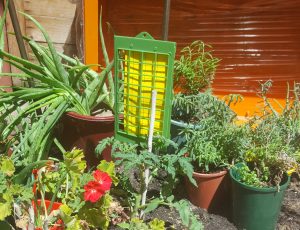National TPP surveillance program delivers first season results
A three-year investment, designed for the early detection of and preparedness for tomato-potato psyllid should it cross from Western Australia into other regions, commenced in mid-2019. AUSVEG National TPP Coordinator Alan Nankivell reports on the latest findings.
In August 2019, all states and territories commenced a three-year national tomato-potato psyllid (TPP) surveillance program.
A strategic levy investment under the Hort Innovation Nursery, Potato – Fresh, Potato – Processing and Vegetable Funds, National tomato potato psyllid and zebra chip surveillance (MT18008) has incorporated the learnings from the initial detection of TPP in Perth over three years ago. The project is being facilitated by the Department of Primary Industries and Regional Development (DPIRD) in Western Australia.
Two strategies have been employed. These are to focus on urban and peri-urban regions and to engage the community in an “Adopt a Trap” initiative, where department staff and community members have volunteered to put out traps and collect them.

In Western Australia, trapping was undertaken in Albany, Geraldton, Carnarvon and Kununurra. In addition, DPIRD continued with its urban and peri-urban surveillance program. Analysis of the traps will be undertaken by the relevant state and territory departments.
It was determined that sampling would be most effective during each state and territory’s growing season, and peak insect activity time. Therefore, sampling was staggered for different regions. For example, in Western Australia, the northern most regions began sampling at the beginning of the project (August 2019), whereas the southern region’s sampling occurred in October and November.
Although most states were sampling in spring, colder regions (e.g. Tasmania) began sampling later in December. Also, the Northern Territory missed its peak sampling period (April-August) due to the late start of the project – the training workshop was held at the end of August. The Top End began conducting its first sampling in April 2020.
TPP analysis
A major benefit of this project is the training of entomologists and micro-biologists across the nation to develop competencies in the identification of TPP and the bacterium it vectors, Candidatus Liberibacter solanacearum (CLso). Each jurisdiction now has current best practice methodologies for the analysis of insects collected throughout the project.
Results to date
WA has detected TPP in Carnarvon (1 male, trap set ~8 September), Albany (21 TPP over four weeks and four properties) and Geraldton (407 TPP over four weeks and eight properties).
Of these, approximately 120 were tested for CLso (all from Albany and Carnarvon, ~100 from Geraldton), but CLso was not detected. This confirms the negative finding of CLso from the Perth metropolitan region from the same spring sample season.
These early detections are a good sign that the program is working and ensures that growers can respond promptly to prevent further TPP outbreaks.
Analysis from all other states has not identified any TPP, and therefore no CLso.

Find out more
For more information on this program, please contact AUSVEG National TPP Coordinator Alan Nankivell at alan.nankivell@ausveg.com.au.
Tomato potato psyllid (TPP) National Program Coordinator has been funded by Hort Innovation using the vegetable, fresh potato and potato processing research and development levies and contributions from the Australian Government.
Project Number: MT16018
This article first appeared in the winter 2020 edition of Vegetables Australia. Click here to read the full publication.

